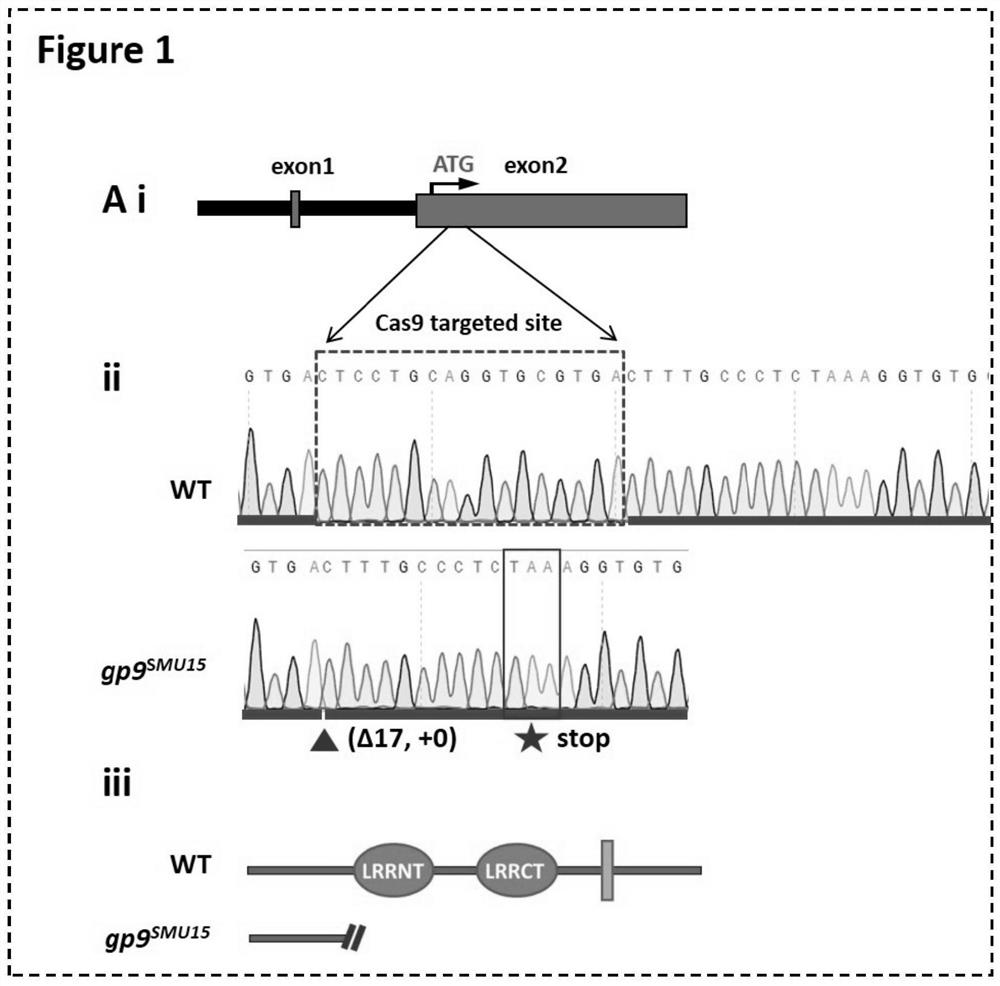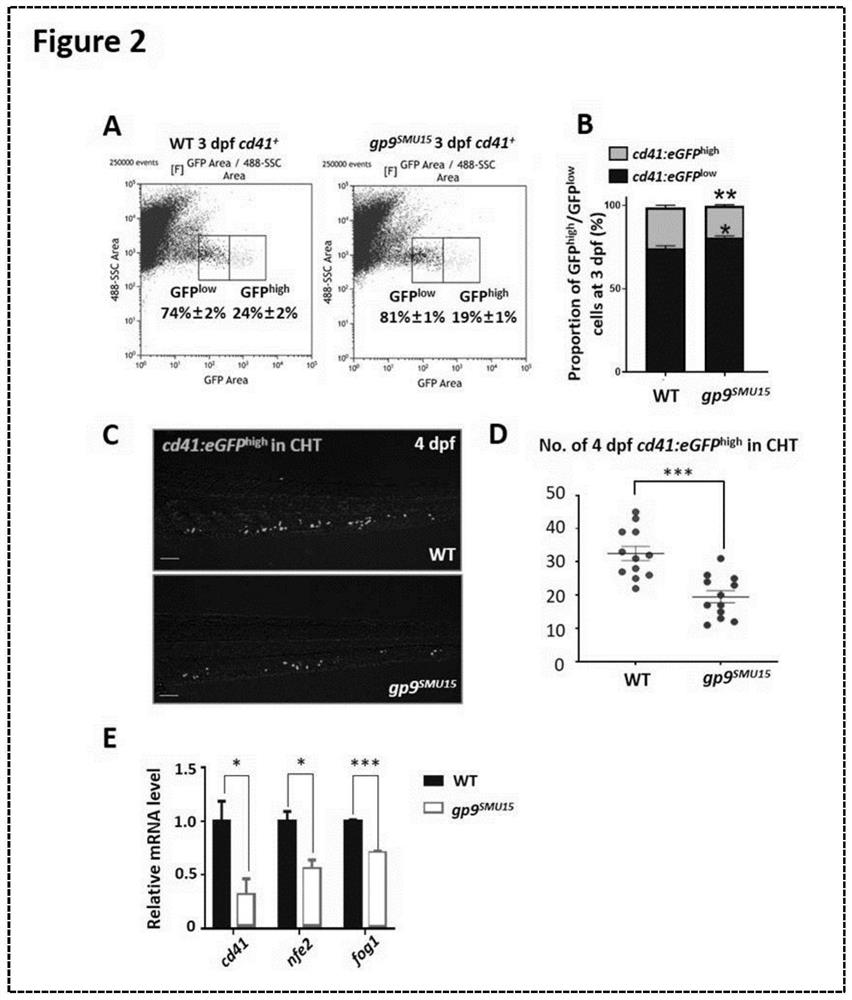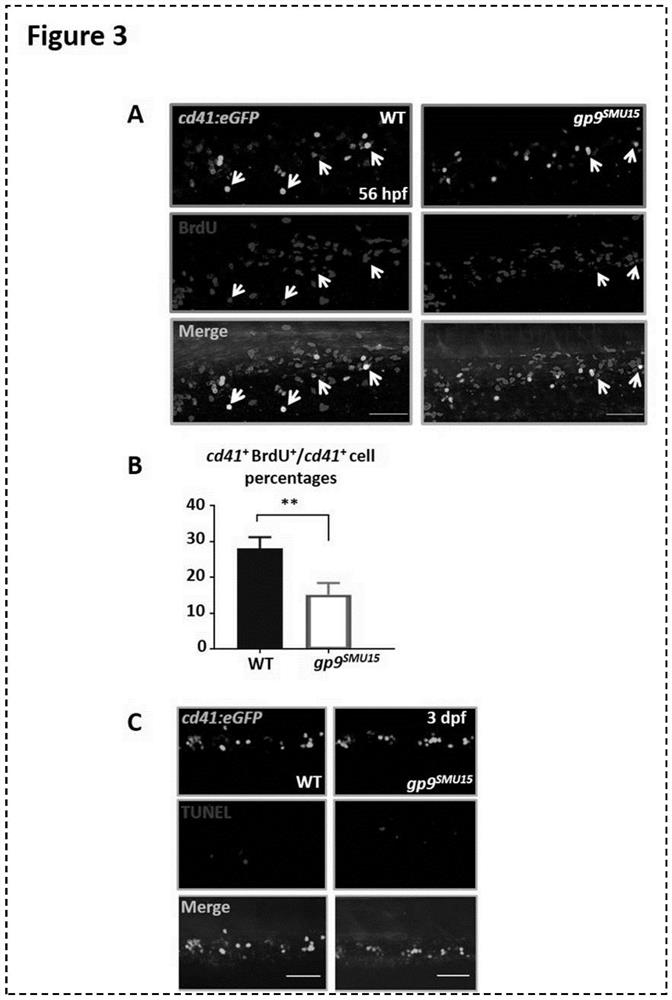Zebra fish model for Bernard-Soulier syndrome
A technology of zebrafish and platelets, which is applied to peptide sources, biochemical equipment and methods, chemical instruments and methods, etc., can solve the problem of uneven bleeding and achieve high egg production, low feeding costs, and low cost Effect
- Summary
- Abstract
- Description
- Claims
- Application Information
AI Technical Summary
Problems solved by technology
Method used
Image
Examples
Embodiment 1
[0039] 1. Materials and methods:
[0040] (1) Zebrafish farming
[0041] Zebrafish were cultured as described in the literature (Westerfield M: The zebrafish: guide for the laboratory use of zebrafish (Brachdanio rerio). Edition by Eugene, OR, M. Westerfield, 1993).
[0042] (2) The following strains are used in the present invention: AB wild-type zebrafish, gp9 SMU15 Mutant zebrafish, Tg(CD41:GFP) transgenic zebrafish. Among them, each transgenic zebrafish line was combined with gp9 SMU15 Crossbreeding of mutant zebrafish followed by selfing to obtain gp9 in a CD41 transgenic background SMU15 Mutant zebrafish such as Tg(CD41:GFP); gp9- / -.
[0043] (3) CRISPR / Cas9-targeted gene knockout of gp9 gene (refer to figure 1 shown)
[0044] Select the sequence after the ATG start codon of exon 2 of the gp9 gene as the sequence for targeted knockout. According to the http: / / www.crisprscan.org / website, the predicted score is high, the target efficiency is high, and the off-tar...
Embodiment 2
[0047] Detection of gp9 by whole-mount in situ hybridization SMU15 Expression of mutant platelet-related genes
[0048] The following standard experimental procedures were followed (Thisse C, Thisse B.(2008).High-resolution in situ hybridization to whole-mount zebrafish embryos.NATUREPROTOCOLS.VOL.3NO.1).
[0049] The result is as figure 2 part C of figure 2 As shown in part D, in 3dpf, gp9 SMU15 The platelet marker cd41 signal in the mutant is less than that of the wild type, indicating that gp9 SMU15 Mutant platelet counts may be reduced.
Embodiment 3
[0050] Embodiment 3Q-PCR detects gp9 SMU15 Expression of mutant platelet-related genes
[0051] Collect 3dpf WT and 3dpfgp9 SMU15 For the mutant fish, use Tripure RNA Isolation Reagent (Thermo, 15596018) to extract the total RNA of the embryo, and follow the instructions in the instructions. cDNA was reverse transcribed with M-MLV reverse transcriptase (Promega, M1701). Zebrafish elf1a was used as an internal reference gene for Q-PCR detection, and the sequence information of the primers is shown in Table 1 below.
[0052] Table 1
[0053]
[0054]
[0055] The result is as figure 2 As shown in part E, in 3dpf, gp9 SMU15 Compared with the wild type, the expression of platelet-related genes cd41, nfe2, and fog1 in the mutant decreased. Combined with the results of whole-body in situ hybridization of cd41, it further explained that in the embryonic period, gp9 SMU15 The number of platelets is reduced in the mutants.
PUM
 Login to View More
Login to View More Abstract
Description
Claims
Application Information
 Login to View More
Login to View More - R&D
- Intellectual Property
- Life Sciences
- Materials
- Tech Scout
- Unparalleled Data Quality
- Higher Quality Content
- 60% Fewer Hallucinations
Browse by: Latest US Patents, China's latest patents, Technical Efficacy Thesaurus, Application Domain, Technology Topic, Popular Technical Reports.
© 2025 PatSnap. All rights reserved.Legal|Privacy policy|Modern Slavery Act Transparency Statement|Sitemap|About US| Contact US: help@patsnap.com



